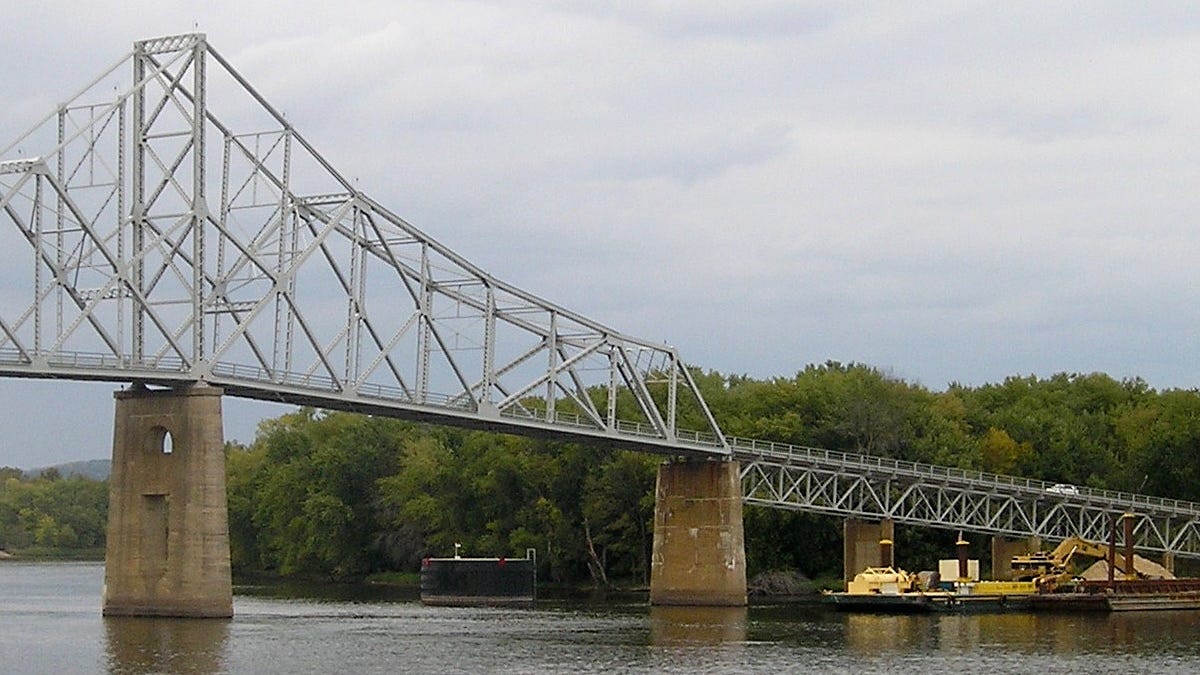Few similarities in Lansing, Baltimore bridge situations
From age to maintenance authority, the circumstances are very different

The Black Hawk Bridge at Lansing and the Francis Scott Key Bridge at Baltimore have been two important bridges over large rivers.
The similarities pretty much stop there.
The tragedy on Tuesday in which a fully loaded container ship lost power and crashed into a support pillar on the Key Bridge, causing the entire structure to fall into the Patapsco River in a matter of seconds, and the temporary closure of a tranquil crossing over the Mississippi River are far apart in every category.
Lansing
The Black Hawk Bridge opened in 1931. Its life has been prolonged not only by routine maintenance, but a 12-year-long closure (1945-57) that ended with major rehabilitation and installation of the steel deck that’s there today.
National Bridge Inventory standards deem it “structurally deficient” — which does not mean unsafe — with a deck “basically intolerable requiring high priority of replacement.” It’s old, it’s narrow and it’s going to cost $140 million to replace.
Movement was detected on part of the structure in February (although apparently it should have been detected earlier) and it’s been shut down while emergency repairs are undertaken. That work is needed to keep the bridge functioning until its replacement is done, which is anticipated for the end of 2026.
Like many major river crossings in the first half of the 20th century, the Black Hawk Bridge was initially built and operated by a private company. Bonds were issued to build, and tolls covered repayment of those bonds and the cost of upkeep. When state governments took possession of such bridges, tolls were lifted and costs were covered through gas taxes. In this case, ice jams put the bridge out of commission in 1945, and Iowa and Wisconsin stepped in to purchase it in 1952. Each state is paying half the cost of the replacement.
Baltimore
The collapse of the Key Bridge is not a data point in America’s infrastructure crisis. The collapse of the Key Bridge is due to a ship one-sixth of a mile long with immense momentum uncontrollably ramming into a main support. Removal of the bridge from the river will take months and those effects will be widespread. The Port of Baltimore can’t function until the river is reopened.
President Joe Biden said, “It’s my intention that the federal government will pay for the entire cost of reconstructing the bridge.”
The extent of federal authority in this case is more complicated than it may seem.
When the interstate highway system was born in 1956, many states had turnpikes in use or planned for construction. But the interstate program and its state-federal cost-sharing had the goal of creating freeways. Certain toll roads and major bridges/tunnels were allowed to be signed as interstates but their maintenance would remain the responsibility of a state agency separate from the main department of roads/highways/transportation and funded through revenue bonds and tolls.
The Maryland Transportation Authority is responsible for toll roads and crossings in that state. The Key Bridge, which opened in 1977, was signed as Toll I-695 for continuity, but officially it’s part of Maryland Highway 695.

When part of a bridge on I-95 in southwest Connecticut collapsed in 1983, the state received emergency federal money on the condition that tolls on I-95 would be removed. However, in 1995, the National Highway System Designation Act created a network of roads “important to the nation’s economy, defense, and mobility.” This designation isn’t just limited to interstates, or non-toll roads for that matter, but the federal contribution tops out at 80%.
Regardless of who will ultimately pay for the Key Bridge’s replacement, a half-century-old structure can’t be rebuilt back the way it was. That’s especially true over wide expanses of water. In 1980 a freighter hit a pier on the Sunshine Skyway and caused part of the skyway to fall into Tampa Bay, causing 35 deaths. The Skyway’s replacement includes large islands of rock surrounding the main pillars and concrete “dolphins” near the smaller ones.
The new bridge will have to be up to 2020s construction standards, not 1970s. It may be desired to be higher above water level to allow larger container and cruise ships into Baltimore Harbor. The entire project will easily top $1 billion and take years. The federal government just committed $1.06 billion toward replacing the I-535 Blatnik Bridge in Duluth, and Minnesota and Wisconsin still had to chip in another $400 million apiece. Its replacement won’t be done until 2032.
If the pilot of the ship that hit the Key Bridge had not sent out a mayday, or if the bridge had collapsed at 1:28 PM instead of 1:28 AM, the loss of life would have been far more than the six construction workers. There is a long road ahead, pardon the expression, for replacing this important link in Maryland.
My other work can be found on my website, Iowa Highway Ends, and its blog.
I am proud to be part of the Iowa Writers’ Collaborative. If you’re interested in commentary by some of Iowa’s best writers, please follow your choice of Collaborative members:




👍good information.